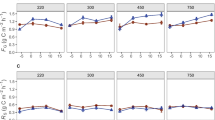Abstract
Soil microbial biomass content, organic carbonmineralization as well as arginine ammonificationrates were estimated in samples from arable andgrassland soils and carbon dioxide and nitrous oxideemission rates were measured in situ at four sitesalong a catena. Soil microbial biomass contentincreased in the order, maize monoculture < croprotation < dry grassland < wet grassland. The twoarable soils had similar rates of carbonmineralization in the laboratory at 22 °C (basalrespiration) as well as in situ (carbon dioxideemission) at field temperature. Under crop rotation,maize monoculture and dry grassland, the arginineammonification rate significantly correlated to themicrobial biomass content. In contrast, thebiomass-specific ammonification rate was low in wetgrassland soil, as were in situ N2O emission rates.Data from all sites together revealed no generalrelationship between microbial biomass content and Cand N mineralization rates. In addition, there was nogeneral relationship between the quantity of soilmicrobial biomass and the emission rates of thegreenhouse gases CO2 and N2O. The maize monocultureinduced a soil microbial community that was lessefficient in using organic carbon compounds, as shownby the high metabolic quotient (respiration rate perunit of biomass). However, microbial biomass contentwas proportional to basal respiration rate in soilsunder crop rotation, dry and wet grassland. Arginineammonification rate was related to microbial biomasscontent only in fertilized soils. Applications of highquantities of inorganic nitrogen and farmyard manureapparently increase in situ N2O emission rates,particularly under crop rotation. The microbialbiomass in the unfertilized wet grassland soil seemsto be a sink for nitrogen.
Similar content being viewed by others
References
Alef K &Kleiner D (1986) Arginine ammonification, a simple method to estimate microbial activity potentials in soils. Soil Biol. Biochem. 18: 233-235
Anderson T-H &Domsch K-H (1990) Application of eco-physiological quotients (qCO2 and qD) on microbial biomasses from soils of different cropping histories. Soil Biol. Biochem. 22: 251-255
Anderson T-H &Domsch K-H (1993) The metabolic quotient for CO2 (qCO2) as a specific activity parameter to assess the effects of environmental conditions, such as pH, on the microbial biomass of forest soils. Soil Biol. Biochem. 25: 393-395
Dashman T &Stotzky G (1986) Microbial utilization of amino acids and a peptide bound on homoionic montmorillonite and kaolinite. Soil Biol. Biochem. 18: 5-14
Dilly O &Munch J-C (1995) Microbial biomass and activities in partly hydromorphic agricultural and forest soils in the Bornhöved Lake region of Northern Germany. Biol. Fertil. Soils 19: 343-347
Drury CF, McKeeney DJ &Findlay WI (1991) Relationship between denitrification, microbial biomass and indigenous soil properties. Soil Biol. Biochem. 23: 751-755
Fine P, Feigin A &Waisel Y (1986) A closed, well-oxygenated system for the determination of the emission of carbon dioxide, nitrous oxide, and ammonia. Soil Sci. Soc. Am. J. 50: 1489-1493
FAO (1988) Soil Map of theWorld. Revised Legend. World Soil Resources Report 60. Rome, 119 p
Forster JC, Zech W &Würdinger E (1993) Comparison of chemical and microbiological methods for the characterization of the maturity of composts from contrasting sources. Biol. Fertil. Soils 16: 93-99
Groffman PM &Tiedje JM (1989) Denitrification in North temperate forest soils: Relationships between denitrification and environmental factors at the landscape scale. Soil Biol. Biochem. 21: 621-626
Heinemeyer O, Insam H, Kaiser E-A &Walenzik G (1989) Soil microbial biomass and respiration measurements: An automated technique based on infra-red gas analysis. Plant Soil 116: 191-195
Heinemeyer O, Walenzik G &Kaiser E-A (1991) Zur Methodik der Bestimmung gasförmiger N-Abgaben in Freilandexperimenten. Mitteilgn. Dtsch. Bodenkundl. Gesellsch. 66: 499-502
Hutchinson GL &Mosier AR (1981) Improved soil cover method for field measurement of nitrous oxide fluxes. Soil Sci. Soc. Am. J. 45: 311-316
Kaiser E-A (1994) Significance of microbial biomass for carbon and nitrogen mineralization in soil. Z. Pflanzenernaehr. Bodenk. 157: 271-278
Kutsch WL &Kappen L (this issue) Aspects of carbon and nitrogen cycling in soils of the Bornhöved Lake district. II. Modelling the influence of temperature increase on soil respiration and soil organic carbon content in arable soils under different management. Biogeochemistry (this issue)
Mahimairaja S, Bolan SN &Hedley MJ (1995) Denitrification losses of N from fresh and composted manures. Soil Biol. Biochem. 27: 1223-1225
Martens R (1995) Current methods for measuring microbial biomass C in soil: Potentials and limitations. Biol. Fertil. Soils 19: 87-99
Munch J-C (1989) Organism specific denitrification in samples of an Udifluvent with different nitrate concentrations. Z. Pflanzenernaehr. Bodenk. 152: 395-400
Scharpf HC, Wehrmann J (1976) Die Bedeutung des Mineralstickstoffvorrats des Bodens zu Vegetationsbeginn für die Bemessung des N-Düngung zu Winterweizen. Landw. Forsch. 32: 100-114
Smith JL, Paul EA (1992) The significance of soil microbial biomass estimations. In: Stotzky G &Bollag J-M (Eds) Soil Biochemistry (pp 357-396). Marcel Dekker, New York
Umarov MM (1990) Biotic sources of nitrous oxide in the context of global budget of nitrous oxide. In: Bouwman AF (Ed) Soils and the Greenhouse Effect (pp 263-268). John Wiley and Sons Ltd, Chichester
Vance ED, Brookes PC &Jenkinson DJ (1987) An extraction method for measuring soil microbial biomass C. Soil Biol. Biochem. 19: 703-707
Wainwright M (1992) The impact of fungi on environmental biogeochemistry. In: Carroll GC &Wicklow DT (Eds) The Fungal Community (pp 601-618). Marcel Dekker, New York
Author information
Authors and Affiliations
Corresponding author
Rights and permissions
About this article
Cite this article
DILLY*, O., KUTSCH, W.L., KAPPEN, L. et al. Aspects of carbon and nitrogen cycling in soils of the Bornhöved Lake district. I. Microbial characteristics and emissions of carbon dioxide and nitrous oxide of arable and grassland soils. Biogeochemistry 39, 189–205 (1997). https://doi.org/10.1023/A:1005867931015
Issue Date:
DOI: https://doi.org/10.1023/A:1005867931015




